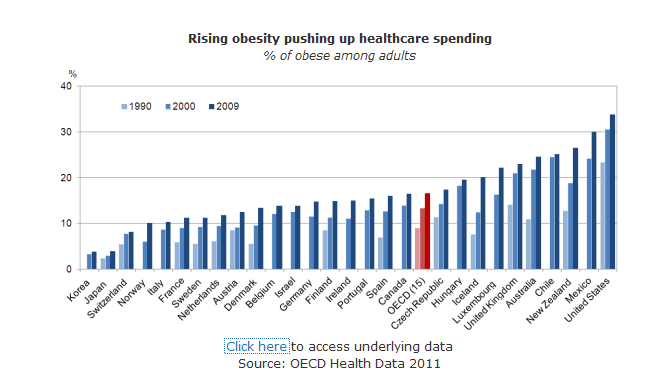Healthcare costs continue to rise in OECD countries. In the United States especially it has increased for many years outpacing inflation. According to the OECD, the US per capita health spending in 2009 was $7,960 which is two and half times that of the OECD average.
One of the reasons for the high cost of healthcare in the U.S. is a higher percentage of the US population is obese compared to other countries. Obesity is the cause of many chronic conditions and people who are over-weight or obese use extensive healthcare services and as a result healthcare costs rises for the overall population. In the Health at a Glance 2011 report, the OECD notes that 50% or more of the population is obese in more than half of the member countries.
Comparison of Obesity Rates Across OECD Countries:
Source: OECD
From the report:
The obesity rate in the adult population is highest in the United States, rising from 15% in 1980 to 34% in 2008, and lowest in Japan and Korea, at 4%.
To tackle this epidemic, many OECD countries are now intensifying efforts to promote a culture of healthy eating and active living. Some have recently introduced taxes on foods high in fat or sugar – e.g. Denmark, Finland, France, and Hungary. However, countries have yet to prove that these policies are sufficient, especially among the poorest in society who are most at risk of obesity. OECD work has shown that a comprehensive prevention strategy combining health promotion campaigns, government regulation and family doctor counselling would avoid hundreds of thousands of deaths from chronic diseases every year. It would cost from USD 10 to USD 30 per person, depending on the country.
Despite the majority of the population dependent on private healthcare in the U.S., public spending on health is very high due to Medicare, Medicaid and other social programs. As the U.S. tries to control healthcare costs, one area where politicians and regulators can focus on is reducing obesity rates in the country. Similar to some of the European countries, the U.S. can consider introducing higher taxes on fatty food items such as cheap fast foods, sugar, etc. As prevention is better than cure, it may not be a bad idea to introduce such taxes and then evaluate the impact in a few years.




